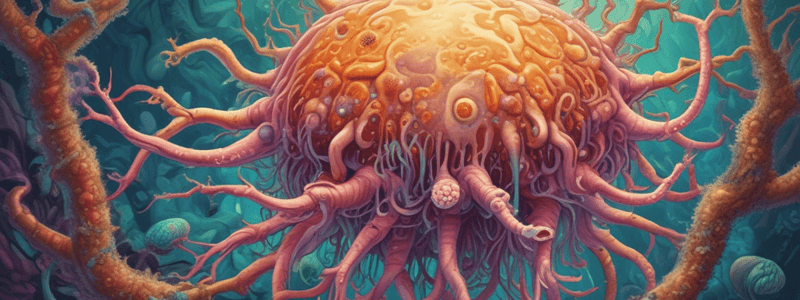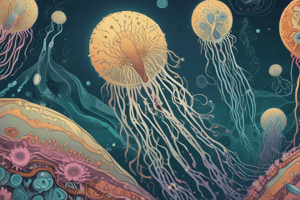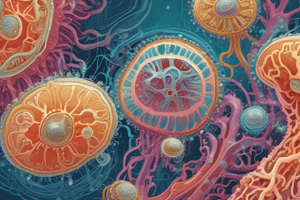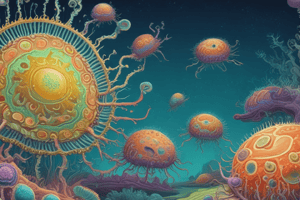Podcast
Questions and Answers
Euglenozoa is a diverse clade that includes ______ and kinetoplastids
Euglenozoa is a diverse clade that includes ______ and kinetoplastids
euglenids
The main feature distinguishing them as a clade is a spiral or crystalline rod of unknown function inside their ______
The main feature distinguishing them as a clade is a spiral or crystalline rod of unknown function inside their ______
flagella
Kinetoplastids have a single ______ with an organized mass of DNA called a kinetoplast
Kinetoplastids have a single ______ with an organized mass of DNA called a kinetoplast
mitochondrion
Some data suggest that the supergroup ______ is monophyletic and originated by a secondary endosymbiosis event
Some data suggest that the supergroup ______ is monophyletic and originated by a secondary endosymbiosis event
Signup and view all the answers
Members of the sub-group ______ have membrane-bounded sacs (alveoli) just under the plasma membrane
Members of the sub-group ______ have membrane-bounded sacs (alveoli) just under the plasma membrane
Signup and view all the answers
Dinoflagellates have two ______ and each cell is reinforced by cellulose plates
Dinoflagellates have two ______ and each cell is reinforced by cellulose plates
Signup and view all the answers
Toxic “red tides” are caused by dinoflagellate ______
Toxic “red tides” are caused by dinoflagellate ______
Signup and view all the answers
The alveolates include – Dinoflagellates – Apicomplexans – ______
The alveolates include – Dinoflagellates – Apicomplexans – ______
Signup and view all the answers
Golden algae are named for their ______ color, which results from their yellow and brown carotenoids
Golden algae are named for their ______ color, which results from their yellow and brown carotenoids
Signup and view all the answers
[Blank] algae are the largest and most complex algae
[Blank] algae are the largest and most complex algae
Signup and view all the answers
The algal body is plantlike but lacks true roots, stems, and leaves and is called a ______
The algal body is plantlike but lacks true roots, stems, and leaves and is called a ______
Signup and view all the answers
Marine protists called ______ have tests fused into one delicate piece, usually made of silica
Marine protists called ______ have tests fused into one delicate piece, usually made of silica
Signup and view all the answers
The ______ of radiolarians radiate from the central body
The ______ of radiolarians radiate from the central body
Signup and view all the answers
Gas-filled ______ help kelp grow vertically in search of light
Gas-filled ______ help kelp grow vertically in search of light
Signup and view all the answers
Some brown algae show complex life cycles that include an alternation of ______ generations
Some brown algae show complex life cycles that include an alternation of ______ generations
Signup and view all the answers
Foraminiferans, or ______, are named for porous, generally multichambered shells, called tests
Foraminiferans, or ______, are named for porous, generally multichambered shells, called tests
Signup and view all the answers
Red algae are reddish in color due to an accessory pigment called ______, which masks the green of chlorophyll
Red algae are reddish in color due to an accessory pigment called ______, which masks the green of chlorophyll
Signup and view all the answers
The diploid ______ produces haploid flagellated spores called zoospores
The diploid ______ produces haploid flagellated spores called zoospores
Signup and view all the answers
DNA evidence suggests that the sub-group ______ is a monophyletic clade
DNA evidence suggests that the sub-group ______ is a monophyletic clade
Signup and view all the answers
The supergroup ______ includes red algae, green algae, and land plants
The supergroup ______ includes red algae, green algae, and land plants
Signup and view all the answers
Rhizarians include ______, forams, and cercozoans
Rhizarians include ______, forams, and cercozoans
Signup and view all the answers
The supergroup ______ includes animals, fungi, and some protists
The supergroup ______ includes animals, fungi, and some protists
Signup and view all the answers
Green algae are usually ______; the largest are seaweeds
Green algae are usually ______; the largest are seaweeds
Signup and view all the answers
The two main groups of green algae are ______ and charophytes, the most closely related to land plants
The two main groups of green algae are ______ and charophytes, the most closely related to land plants
Signup and view all the answers
Study Notes
Euglenozoa
- A diverse clade that includes euglenids and kinetoplastids
- Members can be predatory heterotrophs, photosynthetic autotrophs, or parasites
- Characterized by a spiral or crystalline rod of unknown function inside their flagella
- Euglenids have one or two flagella emerging from a pocket at one end of the cell
- Kinetoplastids have a single mitochondrion with an organized mass of DNA called a kinetoplast
Kinetoplastids
- Include free-living consumers of prokaryotes in freshwater, marine, and moist terrestrial ecosystems
- Trypanosoma gambiense causes sleeping sickness in humans
- Another pathogenic trypanosome causes Chagas' disease leading to congestive heart failure
SAR Supergroup
- May have originated by a secondary endosymbiosis event with a red alga as the endosymbiont
- Includes the alveolates and the stramenopiles
- Controversial clade
Alveolata Subgroup
- Members have membrane-bound sacs (alveoli) just under the plasma membrane
- Function of alveoli is unknown
- Includes dinoflagellates, apicomplexans, and ciliates
Dinoflagellates
- Have two flagella and each cell is reinforced by cellulose plates
- Abundant components of marine and freshwater phytoplankton
- Diverse group of aquatic phototrophs, mixotrophs, and heterotrophs
- Toxic "red tides" are caused by dinoflagellate blooms
Radiolarians
- Marine protists with tests fused into one delicate piece, usually made of silica
- Use pseudopodia to engulf microorganisms through phagocytosis
- Pseudopodia radiate from the central body
Foraminiferans (Forams)
- Named for porous, generally multichambered shells, called tests
- Pseudopodia extend through the pores in the test
- Tests in marine sediments form an extensive fossil record
- Many forams have endosymbiotic algae
Archaeplastida Supergroup
- Includes red algae, green algae, and land plants
Red Algae (Rhodophyta)
- Reddish in color due to accessory pigment phycoerythrin, which masks the green of chlorophyll
- Color varies from greenish-red in shallow water to dark red or almost black in deep water
- Usually multicellular; the largest are seaweeds
- Most abundant large algae in coastal waters of the tropics
Green Algae
- Named for their grass-green chloroplasts
- Plants are descended from green algae
- Paraphyletic group
- Two main groups are chlorophytes and charophytes, with charophytes being the most closely related to land plants
Unikonta Supergroup
- Includes animals, fungi, and some protists
- Includes the amoebozoans and the opisthokonts (animals, fungi, and related protists)
- Root of the eukaryotic tree remains controversial
Slime Molds (Mycetozoans)
- Were once thought to be fungi
Golden Algae
- Named for their color, which results from their yellow and brown carotenoids
- Cells are typically biflagellated, with both flagella near one end
- All are photosynthetic, and some are mixotrophs
- Most are unicellular, but some are colonial
Brown Algae
- Largest and most complex algae
- All are multicellular, and most are marine
- Include many species commonly called "seaweeds"
- Kelp forests are important to marine fish reproduction as food sources and shelter
- Have the most complex multicellular anatomy of all algae
Kelp Forests
- Giant seaweeds that live in deep parts of the ocean
- Algal body is plantlike but lacks true roots, stems, and leaves, and is called a thallus
- Rootlike holdfast anchors the stemlike stipe, which in turn supports the leaflike blades
- Gas-filled bladders help kelp grow vertically in search of light
Studying That Suits You
Use AI to generate personalized quizzes and flashcards to suit your learning preferences.
Related Documents
Description
Learn about Euglenozoa, a clade of diverse organisms including euglenids and kinetoplastids, and their distinct features. Quiz yourself on their flagella, mitochondria, and more.




